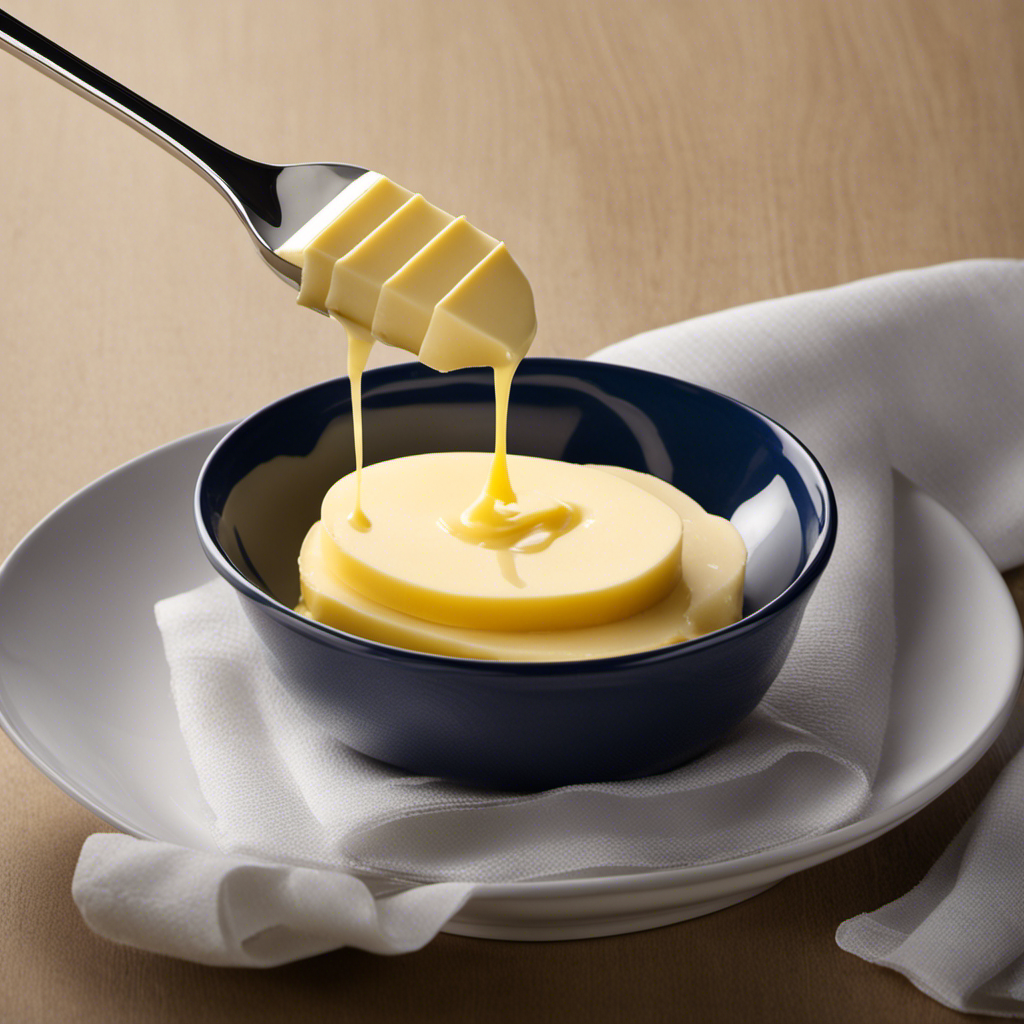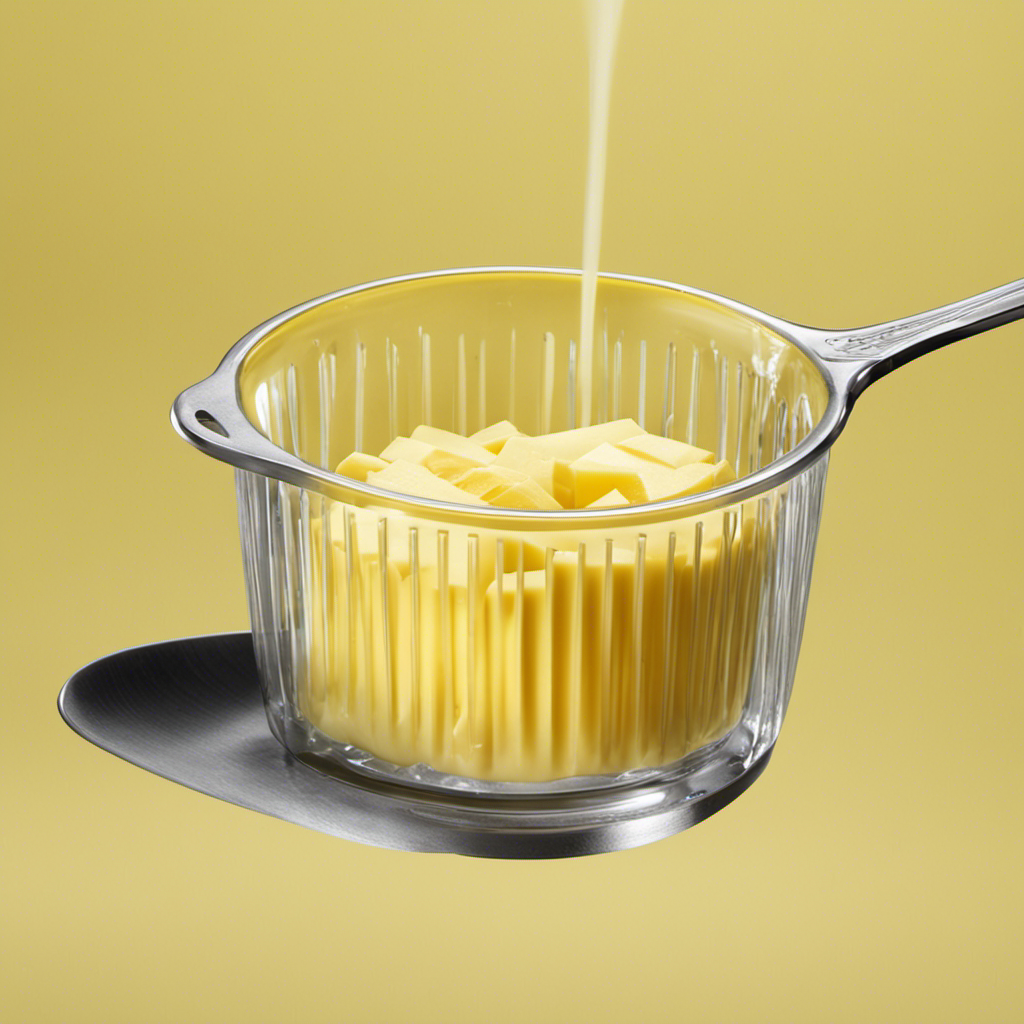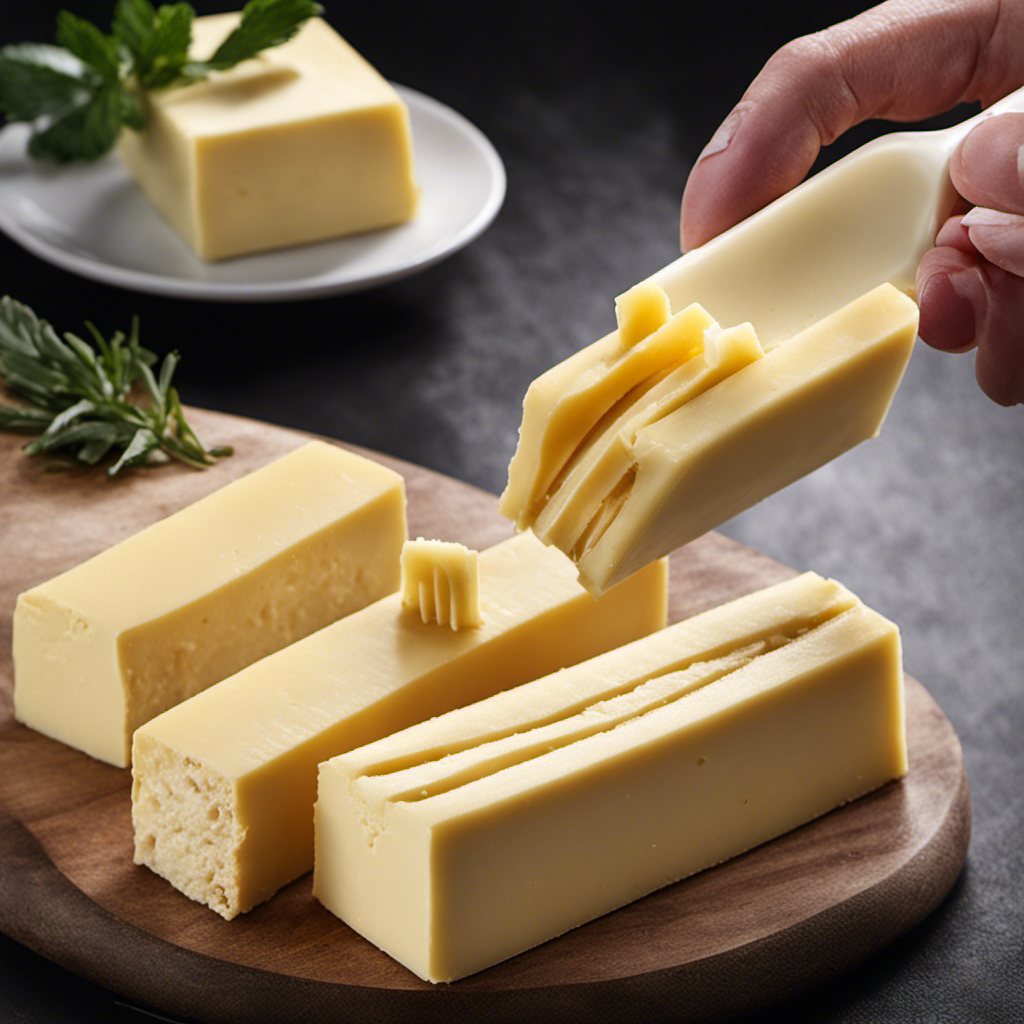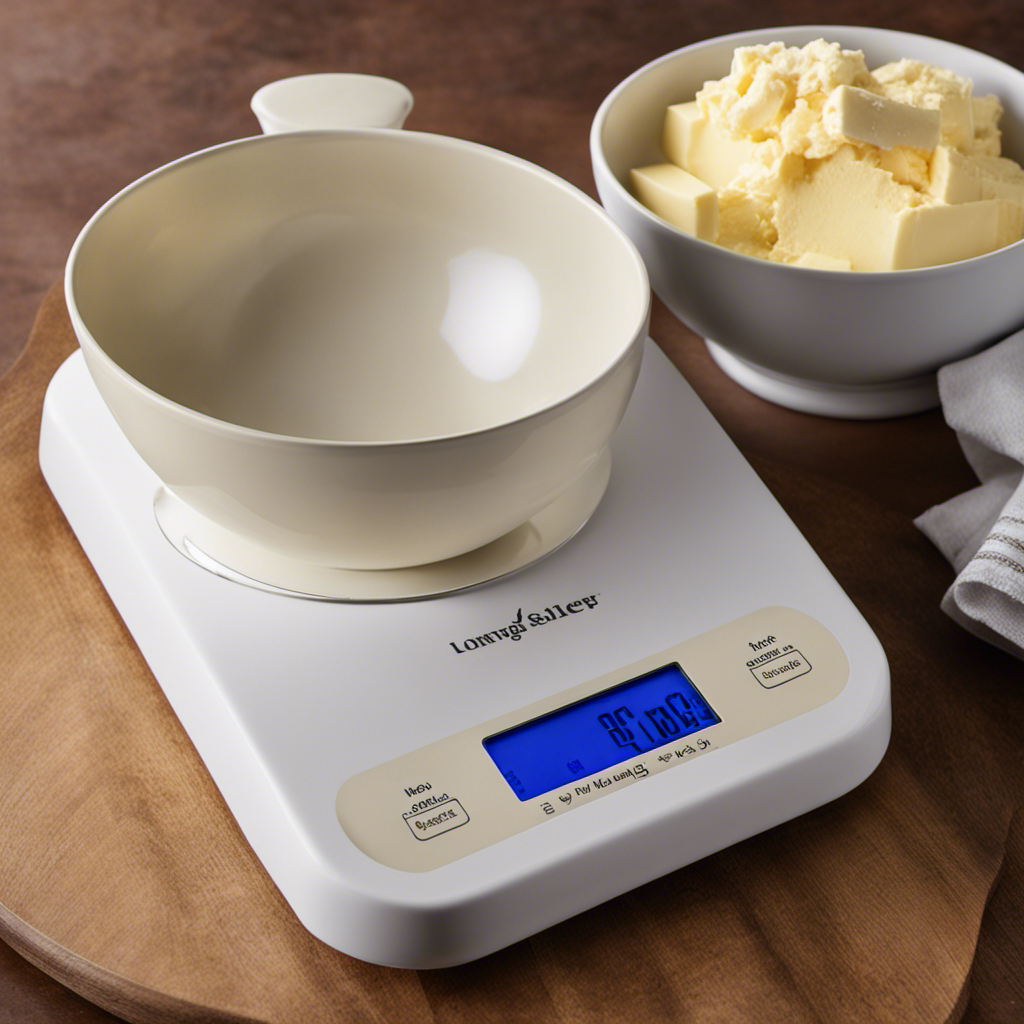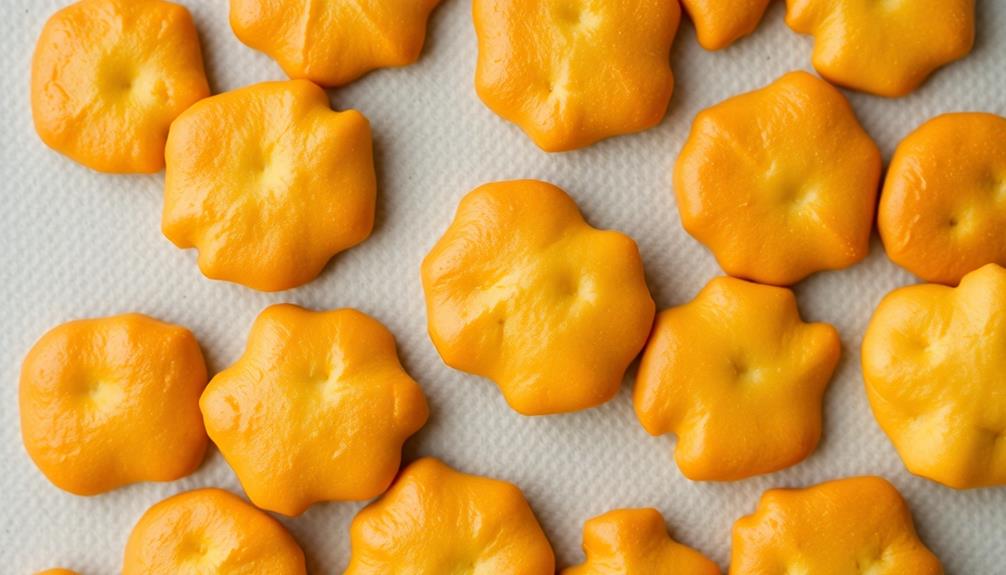Ever been curious about the number of tablespoons in a stick of butter? Your curiosity ends here! This article will explore the realm of butter measurements and reveal the answer to this longstanding question.
Whether you’re a seasoned baker or just starting out in the kitchen, understanding the conversion from sticks to tablespoons is essential. So, grab your apron and get ready to master the art of butter measurement!
Key Takeaways
- A stick of butter weighs 113 grams or 4 ounces.
- A stick of butter is equal to 8 tablespoons.
- Knowing the equivalents of butter measurements is important in recipes.
- Butter packaging can vary, leading to inconsistencies in measurements.
Conversion Chart
You’ll find a handy conversion chart that tells you how many tablespoons are in a stick of butter.
When it comes to butter measurements, it’s important to know the equivalents.
A stick of butter typically weighs 113 grams or 4 ounces, which is equal to 8 tablespoons.
This information is crucial in recipes that call for specific measurements of butter.
Whether you’re baking cookies or making a creamy sauce, having the right amount of butter is essential for achieving the desired taste and texture.
Now that you know how many tablespoons are in a stick of butter, you can confidently follow recipes without any confusion.
But what about other standard measurements? Let’s explore that next.
Standard Measurements
Have you ever found yourself in the middle of a recipe, only to realize you don’t have the right measurements?
Don’t worry, we’ve got you covered with our discussion on measurement conversions explained. We’ll break down those confusing tablespoons and sticks of butter, so you’ll never have to guess again.
And while we’re at it, we’ll also dive into the inconsistent packaging of butter, which can leave you scratching your head in the grocery store aisle.
Measurement Conversions Explained
There’s no need to worry about measurement conversions when it comes to a stick of butter – it’s equivalent to 8 tablespoons.
But what if you don’t have a stick of butter on hand? Don’t fret, there are plenty of butter substitutes available. Margarine, coconut oil, and vegetable shortening can all be used as alternatives. However, keep in mind that these substitutes have different compositions and flavors, so they may not give you the exact same results in your recipes.
When substituting, it’s important to consider the purpose of the butter in the recipe. Is it for flavor, texture, or both? Experimentation and taste-testing may be necessary to find the perfect substitute.
Butter Packaging Inconsistencies
The inconsistent packaging of butter can make it difficult to determine the exact amount needed for a recipe. One day, you buy a stick of butter and it measures exactly 1/2 cup. The next day, you buy another stick from a different brand, and it measures slightly less than 1/2 cup. It’s frustrating, to say the least. To give you an idea of just how varied butter packaging can be, here’s a table showcasing the differences in measurements:
| Brand | Weight (oz) | Cups |
|---|---|---|
| A | 4 | 1/2 |
| B | 3.75 | 1/2 |
| C | 3.5 | 7/16 |
| D | 4.5 | 9/16 |
| E | 4.25 | 1/2 |
These inconsistencies can throw off your recipe and leave you frustrated. It’s important to be aware of these variations, especially if you’re using butter as a substitute for other ingredients. Speaking of butter packaging, let’s dive into the regulations and guidelines that govern this industry.
Butter Packaging
You can find the quantity of tablespoons in a stick of butter by checking the packaging. Butter packaging design varies, but most commonly, a stick of butter is labeled as 1/2 cup or 8 tablespoons.
This information is essential for cooking and baking, as many recipes call for specific measurements of butter. The packaging also provides helpful storage tips to keep your butter fresh and flavorful.
It is recommended to store butter in the refrigerator, tightly wrapped or sealed to prevent it from absorbing odors. If you prefer to keep butter at room temperature for easier spreading, use a butter dish or a butter keeper with a lid to protect it from air and contaminants.
Butter Brands
When choosing a brand of butter, consider the flavor and texture you prefer. There are so many options out there, each with their own unique qualities. Here are four things to keep in mind when selecting a butter brand:
-
Taste: Some brands have a rich and creamy flavor, while others have a slightly tangy or salty taste. Think about how you plan to use the butter and what flavors will complement your dishes best.
-
Texture: Butter can range from soft and spreadable to firm and sliceable. Consider how you like to use butter in your cooking and baking, and choose a brand that has the right consistency for your needs.
-
Ingredients: If you’re looking for a healthier option, you may want to consider butter substitutes or brands that offer lower fat or salt content. Check the nutritional information on the packaging to make an informed choice.
-
Price: Butter brands can vary in price, so it’s good to keep your budget in mind. However, remember that sometimes the quality of the butter is worth the extra cost.
Now that you have a better understanding of what to look for in a butter brand, let’s move on to some baking and cooking tips.
Baking and Cooking Tips
Now that we’re talking about baking and cooking tips, let’s explore some helpful techniques to enhance your culinary creations.
When it comes to baking, sometimes you may find yourself in need of a butter substitute. Whether you’re looking to reduce saturated fat or accommodate dietary restrictions, there are several options available. Coconut oil, applesauce, and Greek yogurt can all be used as substitutes for butter in baking recipes. Each of these alternatives will yield slightly different results, so it’s important to experiment and find the one that works best for your desired outcome.
Additionally, proper storage of butter is crucial to maintaining its freshness and flavor. It’s recommended to store butter in an airtight container in the refrigerator, away from strong odors. This will help prevent it from absorbing unwanted flavors and keep it tasting its best.
Other Butter Equivalents
Are you tired of constantly referring to a butter conversion chart every time you come across a recipe that uses a different measurement for butter? Well, look no further!
In this discussion, we will explore a handy butter conversion chart that will make your life in the kitchen much easier.
Additionally, we will delve into alternative butter measurements that can come in handy when you don’t have the exact amount of butter required.
Butter Conversion Chart
To find out how many tablespoons are in a stick of butter, you can refer to a butter conversion chart. This chart is a handy tool that provides accurate measurements for various butter quantities. Here are four reasons why a butter conversion chart is essential:
-
Accurate measurements: The chart ensures you use the right amount of butter in your recipes, preventing any inconsistencies in taste or texture.
-
Convenience: Instead of guessing or estimating, the chart gives you precise measurements, saving you time and effort.
-
Consistency: Using a conversion chart ensures that your dishes turn out the same every time you make them, creating a reliable and enjoyable cooking experience.
-
Butter substitutes: The chart can also help you determine the equivalent amount of butter substitutes like margarine or oil, making it versatile for different dietary preferences or restrictions.
Next time you’re in the kitchen, refer to a butter conversion chart to make your cooking experience a breeze.
Alternative Butter Measurements
Refer to the handy butter conversion chart to easily determine the appropriate measurements for alternative butter substitutes like margarine or oil.
When it comes to baking or cooking, sometimes you may not have butter on hand or prefer to use a different option. Butter substitutes are great alternatives, but it’s important to know the correct measurements to ensure your recipes turn out just right.
One key factor to consider is the butter melting point. Margarine, for example, has a lower melting point than butter, which means it may not provide the same texture and flavor in certain recipes. Oil, on the other hand, has a higher melting point, so it may not be suitable for recipes that require the solid structure of butter.
Common Recipes With Butter
You’ll find butter in many common recipes, like cookies, cakes, and mashed potatoes. It adds a rich and creamy flavor to these dishes that is hard to replicate.
However, if you’re looking for alternatives to butter, there are a few options available. Some popular butter substitutes include margarine, coconut oil, and olive oil. These can be used in equal amounts as a replacement for butter in most recipes.
When it comes to storing butter, it’s important to keep it in a cool, dry place. Avoid storing it in the refrigerator, as this can cause the butter to become hard and difficult to spread. Instead, opt for a butter dish or a covered container on the counter or in the pantry. This will help to keep the butter soft and ready to use whenever you need it.
Conclusion
So there you have it, my friend! Now you know exactly how many tablespoons are in a stick of butter. It’s a handy piece of knowledge to have in your culinary arsenal.
Remember, when you’re baking up a storm or whipping up a delicious meal, butter is your secret ingredient for success. Whether you’re using it to sauté veggies or slather it on warm, fluffy biscuits, butter adds that extra touch of richness and flavor that will make your taste buds dance with joy.
So go ahead, embrace the buttery goodness and let your culinary adventures begin! Trust me, with butter in hand, the possibilities are as endless as the sky.
